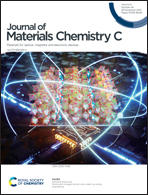“Dragging mode” electrohydrodynamic jet printing of polymer-wrapped semiconducting single-walled carbon nanotubes for NO gas-sensing field-effect transistors†
Abstract
In this study, we investigated facile “dragging mode” electrohydrodynamic (EHD) jet printing of a polymer-wrapped semiconducting single-walled carbon nanotube (s-SWCNT) ink, for fabrication of NO gas-sensing field-effect transistors (FETs). The “dragging mode” provides a favorable environment for reliable printing and interconnection between the s-SWCNTs. Printing parameters such as supply voltages, printing speeds, and the number of prints were manipulated to find an optimal printing condition and obtain high-performance FETs. Under optimal conditions, the polymer-wrapped s-SWCNT-based FETs exhibited an average field-effect mobility of 2.939 cm2 (V−1 s−1), a threshold voltage of 2.21 V, an on/off ratio of ∼103, and a subthreshold swing of 0.968 V dec−1. Additionally, we demonstrated the application of FETs as NO sensors with high sensitivity and selectivity. The FET-type NO gas sensor exhibits a dynamic sensing range of 500 ppb–30 ppm and clear selectivity among various analyte gases including ethanol, ammonia, and acetone. Therefore, the “dragging mode” EHD jet printing introduced in this study simplifies patterning processes and is a potential reproducible method for the fabrication of next-generation gas sensors.



 Please wait while we load your content...
Please wait while we load your content...